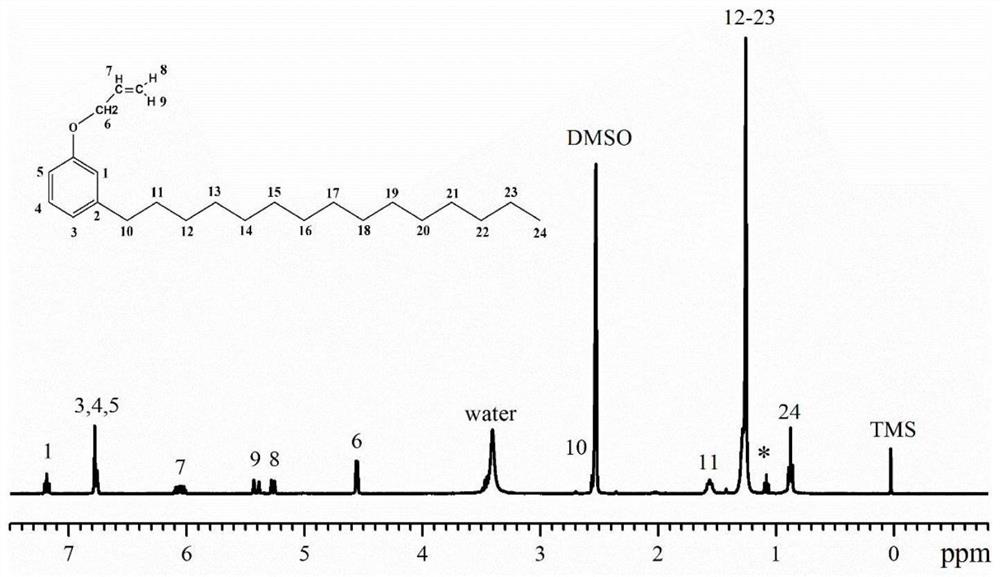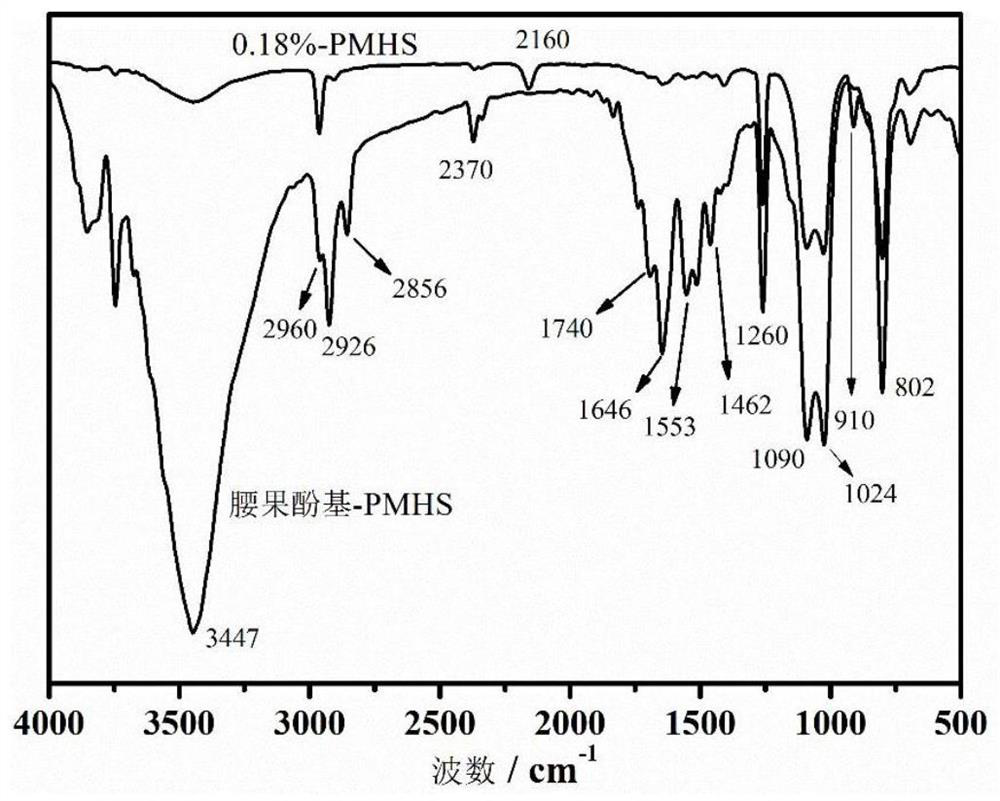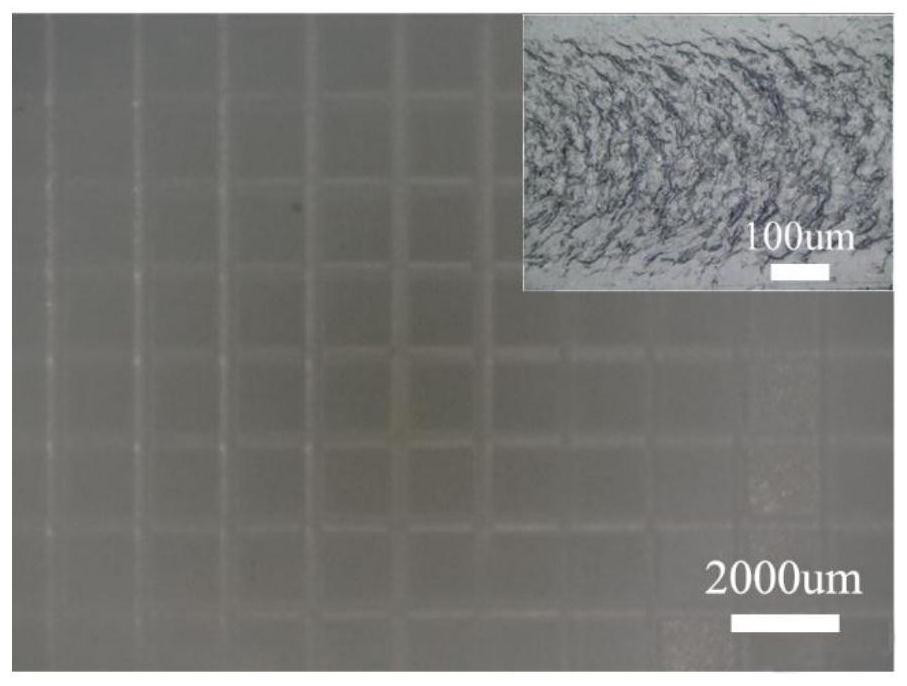Bio-based polysiloxane scratch-resistant auxiliary agent and preparation method thereof, and scratch-resistant composite material
A polysiloxane, bio-based technology, applied in the field of anti-scratch additives, can solve the problems of violating green development, non-renewable non-green resources, etc.
- Summary
- Abstract
- Description
- Claims
- Application Information
AI Technical Summary
Problems solved by technology
Method used
Image
Examples
preparation example Construction
[0047] The present invention provides a preparation method of the bio-based polysiloxane anti-scratch additive described in the technical solution, comprising the following steps:
[0048] (1) mix hydrogenated cardanol, basic catalyst, organic solvent and halogenated olefin, and carry out substitution reaction to obtain intermediate;
[0049] (2) Mix the intermediate obtained in the step (1) with the catalyst, toluene and low-hydrogen polysiloxane, and carry out a hydrosilylation reaction to obtain the bio-based polysiloxane of the formula (I) structure Scratch-resistant additives;
[0050] Alternatively, the unhydrogenated cardanol is mixed with the catalyst, toluene and low-hydrogen-containing polysiloxane for hydrosilylation reaction to obtain the bio-based polysiloxane anti-scratch additive with the structure of formula (II).
[0051] The invention mixes hydrogenated cardanol, a basic catalyst, an organic solvent and a halogenated olefin, and performs a substitution react...
Embodiment 1
[0113] (1) Add the weighed cardanol derivative 3-pentadecylphenol (10mmol, 3.0451g) into 50mL of absolute ethanol solution, stir to dissolve it, and obtain the first reaction solution; / L KOH solution was added to the first reaction solution at a rate of 0.2-0.5mL / s; the bromopropene (10mmol, 0.86g) solution was gradually added dropwise to the first reaction solution at a rate of 0.06-0.12mL / s with a syringe solution to obtain a second reaction solution; heat the second reaction solution to reflux in an oil bath, set the temperature to 78° C., and react for 8 hours; use ethyl acetate to precipitate KBr generated in the reacted system, and filter to obtain the filtrate, set The temperature is 50°C for rotary steaming, the rotary steaming step is repeated twice to remove KBr; the wet method is passed through the column, and the eluent is prepared according to the ratio of petroleum ether: ethyl acetate = 10:1 ~ 20:1, and the column is purified The intermediate; the purified inte...
Embodiment 2
[0124] The difference from Example 1 is that the cardanol derivatives in step (1) are unhydrogenated cardanol; wherein, the unhydrogenated cardanol is a mixture, that is, four kinds of phenols composed of b=0,1,2,3 Composed of mixed phenols. The ratio of the amount of unhydrogenated cardanol, alkaline catalyst and propylene bromide is 1:1:1; the obtained intermediate is a mixed olefin composed of four cardanol groups, wherein the structural formula of the cardanol group mixed olefin is as follows Shown in formula (VII):
[0125]
[0126] b=0,1,2,3 in the formula (VII).
[0127] Step (2) The ratio of the amount of intermediate to chloroplatinic acid and low hydrogen-containing polysiloxane is 12:5.80×10 -7 :12. All the other operating steps are the same as in Example 1.
[0128] The structural formula of the bio-based-PMHS that step (2) obtains is shown in formula (VIII):
[0129]
[0130] Wherein, in formula (VIII), b=0,1,2,3.
PUM
 Login to View More
Login to View More Abstract
Description
Claims
Application Information
 Login to View More
Login to View More - R&D
- Intellectual Property
- Life Sciences
- Materials
- Tech Scout
- Unparalleled Data Quality
- Higher Quality Content
- 60% Fewer Hallucinations
Browse by: Latest US Patents, China's latest patents, Technical Efficacy Thesaurus, Application Domain, Technology Topic, Popular Technical Reports.
© 2025 PatSnap. All rights reserved.Legal|Privacy policy|Modern Slavery Act Transparency Statement|Sitemap|About US| Contact US: help@patsnap.com



